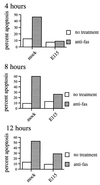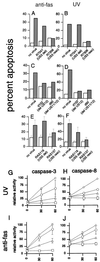Herpes simplex virus inhibits apoptosis through the action of two genes, Us5 and Us3
- PMID: 10516000
- PMCID: PMC112926
- DOI: 10.1128/JVI.73.11.8950-8957.1999
Herpes simplex virus inhibits apoptosis through the action of two genes, Us5 and Us3
Abstract
Apoptosis of virus-infected cells occurs either as a direct response to viral infection or upon recognition of infection by the host immune response. Apoptosis reduces production of new virus from these cells, and therefore viruses have evolved inhibitory mechanisms. We previously showed that laboratory strains of herpes simplex virus type 1 (HSV-1) protect infected cells from apoptosis induced by cytotoxic T lymphocytes or ethanol. We have now evaluated the ability of HSV-1 and HSV-2 laboratory and clinical isolates to inhibit apoptosis induced by anti-Fas antibody or UV irradiation and explored the genetic basis for this inhibition. HSV-1 isolates inhibited apoptosis induced by UV or anti-Fas antibody. In contrast, HSV-2 clinical isolates failed to inhibit apoptosis induced by either stimulus, although the HSV-2 laboratory strain 333 had a partial inhibitory effect on UV-induced apoptosis. Inhibition of apoptosis by HSV was accompanied by marked reduction of caspase-3 and caspase-8 activity. Deletion of the HSV-1 Us3 gene markedly reduced inhibition of UV-induced apoptosis and partially abrogated inhibition of Fas-mediated apoptosis. Conversely, deletion of the HSV-1 Us5 gene markedly reduced protection from Fas-mediated apoptosis and partially abrogated protection from UV. The Us11 and Us12 genes were not necessary for protection from apoptosis induced by either stimulus. The differences between HSV-1 and HSV-2 in the ability to inhibit apoptosis may be factors in the immunobiology of HSV infections.
Figures






References
-
- Ashkenazi A, Dixit V M. Death receptors: signaling and modulation. Science. 1998;281:1305–1308. - PubMed
-
- Balan P, Davis-Poynter N, Bell S, Atkinson H, Browne H, Minson T. An analysis of the in vitro and in vivo phenotypes of mutants of herpes simplex virus type 1 lacking glycoproteins gG, gE, gI or the putative gJ. J Gen Virol. 1994;75:1245–1258. - PubMed
-
- Barry M, McFadden G. Apoptosis regulators from DNA viruses. Curr Opin Immunol. 1998;10:422–430. - PubMed
Publication types
MeSH terms
Substances
Grants and funding
LinkOut - more resources
Full Text Sources
Other Literature Sources
Research Materials
Miscellaneous

